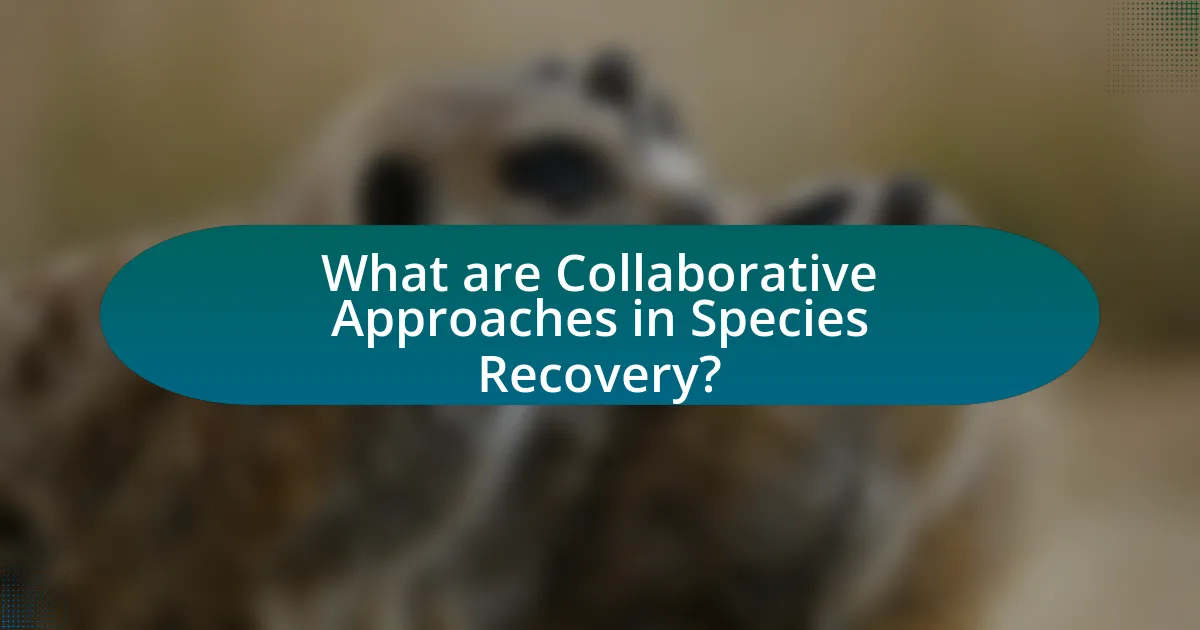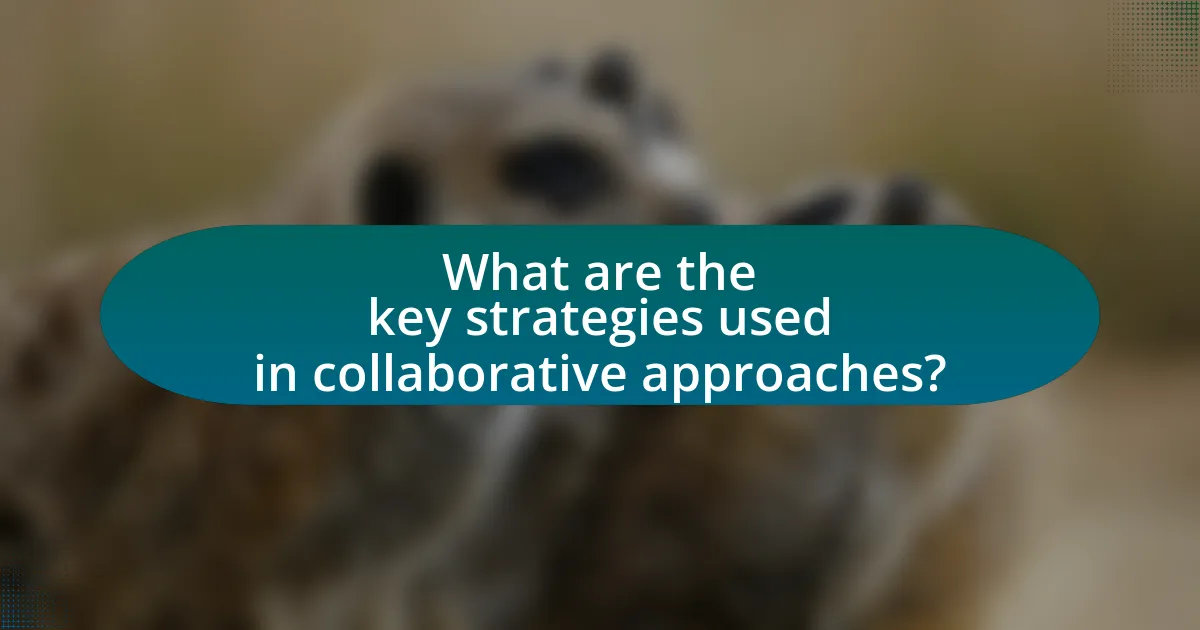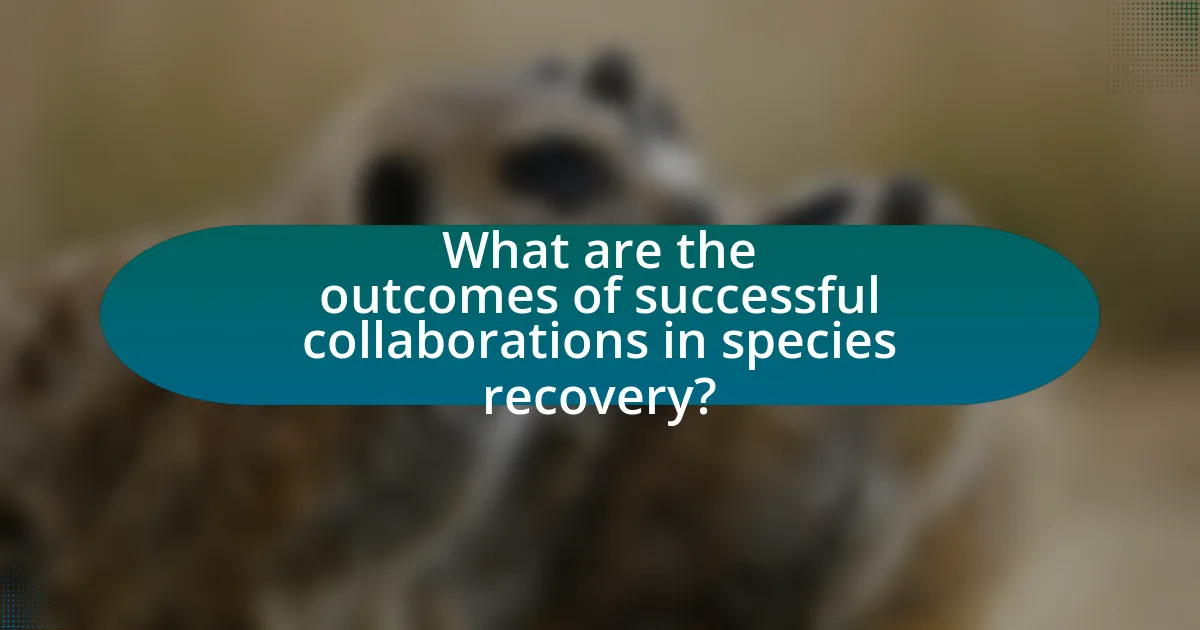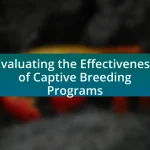Collaborative approaches in species recovery involve partnerships between non-governmental organizations (NGOs), government agencies, local communities, and scientists to enhance conservation efforts. These collaborations leverage diverse expertise and resources, facilitating effective recovery strategies for endangered species. The article outlines how NGOs and governments work together through joint research, funding mechanisms, and stakeholder engagement to identify priority species and implement conservation initiatives. It also discusses the roles and responsibilities of each party, the importance of collaboration in addressing ecological challenges, and the outcomes of successful partnerships in species recovery. Key strategies for enhancing collaboration and lessons learned from past efforts are also highlighted.

What are Collaborative Approaches in Species Recovery?
Collaborative approaches in species recovery involve partnerships between various stakeholders, including non-governmental organizations (NGOs), government agencies, local communities, and scientists, to enhance conservation efforts. These partnerships leverage diverse expertise and resources, facilitating the development and implementation of effective recovery strategies. For instance, the U.S. Fish and Wildlife Service often collaborates with NGOs like the Nature Conservancy to restore habitats and protect endangered species, demonstrating the effectiveness of shared goals and combined efforts in achieving successful recovery outcomes.
How do NGOs and Governments collaborate in species recovery efforts?
NGOs and governments collaborate in species recovery efforts through partnerships that leverage resources, expertise, and community engagement. These collaborations often involve joint research initiatives, where NGOs provide field data and conservation strategies, while governments offer regulatory support and funding. For example, the U.S. Fish and Wildlife Service frequently partners with NGOs like the Nature Conservancy to implement habitat restoration projects, which have led to the recovery of endangered species such as the California condor. This synergy enhances the effectiveness of conservation actions by combining the operational flexibility of NGOs with the authority and resources of government agencies.
What roles do NGOs play in species recovery initiatives?
NGOs play critical roles in species recovery initiatives by conducting research, advocating for policy changes, and implementing conservation programs. These organizations often gather and analyze data on endangered species, which informs recovery strategies and helps prioritize actions. For example, the World Wildlife Fund has been instrumental in the recovery of species like the giant panda through habitat preservation and community engagement. Additionally, NGOs frequently collaborate with governments and local communities to raise awareness and mobilize resources, enhancing the effectiveness of recovery efforts. Their ability to leverage funding and foster partnerships further amplifies their impact on biodiversity conservation.
What responsibilities do governments have in these collaborations?
Governments have the responsibility to create and enforce policies that facilitate collaboration with NGOs in species recovery efforts. This includes providing funding, establishing legal frameworks, and ensuring compliance with environmental regulations. For instance, the Endangered Species Act in the United States mandates government involvement in the protection of threatened species, which often requires partnerships with NGOs for effective implementation. Additionally, governments must engage in data sharing and transparency to support collaborative research and conservation initiatives, as seen in successful programs like the European Union’s LIFE program, which funds conservation projects through partnerships between public and private entities.
Why are collaborative approaches important for species recovery?
Collaborative approaches are important for species recovery because they leverage the strengths and resources of multiple stakeholders, including governments, NGOs, and local communities. This collaboration enhances the effectiveness of conservation efforts by combining scientific expertise, funding, and local knowledge, which is crucial for addressing complex ecological challenges. For instance, the recovery of the California condor involved partnerships between federal agencies, state wildlife departments, and conservation organizations, resulting in increased population numbers from 27 individuals in 1987 to over 500 today. Such collaborative efforts ensure a more comprehensive strategy that can adapt to changing environmental conditions and stakeholder needs, ultimately leading to more successful recovery outcomes.
What challenges do species face that necessitate collaboration?
Species face challenges such as habitat loss, climate change, and resource scarcity that necessitate collaboration. Habitat loss due to urbanization and agriculture reduces the living space and resources available for many species, leading to population declines. Climate change alters ecosystems and disrupts food chains, making it difficult for species to adapt. Resource scarcity, particularly in water and food, forces species to compete, often leading to conflict and further endangerment. Collaborative efforts between NGOs and governments can address these challenges through coordinated conservation strategies, habitat restoration projects, and policy advocacy, ultimately enhancing species recovery and ecosystem resilience.
How does collaboration enhance the effectiveness of recovery efforts?
Collaboration enhances the effectiveness of recovery efforts by pooling resources, expertise, and knowledge from various stakeholders, including NGOs and governments. This collective approach allows for a more comprehensive understanding of the challenges faced in species recovery, leading to more effective strategies. For instance, a study by the National Oceanic and Atmospheric Administration (NOAA) found that collaborative efforts in marine species recovery resulted in a 30% increase in population numbers compared to isolated initiatives. By sharing data and best practices, stakeholders can implement targeted actions that address specific threats, thereby improving overall recovery outcomes.

What are the key strategies used in collaborative approaches?
Key strategies used in collaborative approaches include stakeholder engagement, shared decision-making, and resource pooling. Stakeholder engagement involves actively involving all relevant parties, such as NGOs, government agencies, and local communities, to ensure diverse perspectives are considered. Shared decision-making allows these stakeholders to collaboratively develop and implement strategies, fostering ownership and commitment to the outcomes. Resource pooling refers to the collaboration of financial, human, and technical resources among partners, enhancing the capacity to address species recovery effectively. These strategies have been shown to improve project outcomes, as evidenced by successful conservation initiatives that rely on multi-stakeholder collaboration.
How do NGOs and governments identify priority species for recovery?
NGOs and governments identify priority species for recovery through a combination of scientific assessments, stakeholder consultations, and conservation status evaluations. Scientific assessments involve analyzing population data, habitat conditions, and threats to species, often utilizing frameworks like the IUCN Red List, which categorizes species based on their risk of extinction. Stakeholder consultations engage local communities, experts, and conservationists to gather insights on ecological significance and socio-economic factors. Additionally, conservation status evaluations consider legal protections and existing recovery plans, ensuring that efforts are directed towards species that are most at risk and have the potential for successful recovery. This multi-faceted approach ensures that resources are allocated effectively to maximize conservation outcomes.
What criteria are used to select species for conservation efforts?
Species are selected for conservation efforts based on criteria such as their risk of extinction, ecological significance, and socio-economic value. The International Union for Conservation of Nature (IUCN) Red List assesses species’ extinction risk using criteria like population size, rate of decline, and geographic range. Additionally, species that play critical roles in their ecosystems, such as keystone species, are prioritized for conservation due to their impact on biodiversity. Furthermore, species that have cultural, economic, or medicinal importance to local communities are also considered, as their conservation can support human livelihoods and promote community engagement in conservation efforts.
How is data shared between NGOs and governments in this process?
Data is shared between NGOs and governments through structured partnerships and collaborative platforms. These partnerships often involve formal agreements that outline data-sharing protocols, ensuring that both parties have access to relevant information for species recovery efforts. For instance, NGOs may provide field data on species populations, while governments can share regulatory information and conservation policies. This exchange is facilitated by technology, such as shared databases and online communication tools, which enhance transparency and efficiency in conservation initiatives. Evidence of effective data sharing can be seen in projects like the IUCN Red List, where NGOs and governments collaborate to update species status and conservation needs, demonstrating the importance of integrated data for informed decision-making in species recovery.
What funding mechanisms support collaborative species recovery?
Collaborative species recovery is supported by various funding mechanisms, including government grants, private donations, and international conservation funds. Government grants, such as those from the U.S. Fish and Wildlife Service, provide financial resources for recovery plans and habitat restoration projects. Private donations from individuals and organizations contribute significantly to non-profit initiatives aimed at species recovery. Additionally, international conservation funds, like the Global Environment Facility, offer financial support for transboundary conservation efforts, enabling collaboration between multiple stakeholders. These funding sources are essential for implementing effective recovery strategies and ensuring the sustainability of endangered species.
How do NGOs secure funding for their initiatives?
NGOs secure funding for their initiatives through a combination of grants, donations, fundraising events, and partnerships with governmental and private organizations. For instance, many NGOs apply for grants from foundations and government agencies that support specific causes, such as environmental conservation or community development. According to the National Council of Nonprofits, approximately 30% of nonprofit funding comes from grants, highlighting the importance of this funding source. Additionally, NGOs often engage in fundraising campaigns and events to attract individual donations, which can significantly contribute to their financial resources. Collaborations with businesses and other organizations can also provide financial support, as seen in partnerships that align with corporate social responsibility goals.
What role do government grants play in supporting recovery efforts?
Government grants play a crucial role in supporting recovery efforts by providing essential funding for conservation projects and initiatives. These grants enable organizations, including NGOs and governmental bodies, to implement strategies aimed at restoring endangered species and their habitats. For instance, the U.S. Fish and Wildlife Service allocates millions of dollars annually through grants to support species recovery plans, which have been instrumental in the resurgence of species such as the California condor and the gray wolf. This financial support facilitates research, habitat restoration, and community engagement, thereby enhancing the effectiveness of recovery efforts.

What are the outcomes of successful collaborations in species recovery?
Successful collaborations in species recovery lead to increased population numbers, improved habitat restoration, and enhanced biodiversity. For instance, the partnership between the U.S. Fish and Wildlife Service and various NGOs has resulted in the recovery of the California condor, which increased from 27 individuals in 1987 to over 500 in 2021 due to coordinated breeding and release programs. Additionally, collaborative efforts often result in shared resources and knowledge, enabling more effective conservation strategies, as seen in the joint initiatives for the recovery of the Florida panther, which have improved genetic diversity and population stability. These outcomes demonstrate that effective collaboration between NGOs and governments can significantly enhance species recovery efforts.
How can we measure the success of collaborative species recovery efforts?
Success in collaborative species recovery efforts can be measured through specific metrics such as population trends, habitat restoration, and stakeholder engagement. Population trends provide quantitative data on species numbers, indicating whether populations are increasing or stabilizing due to recovery actions. For instance, the recovery of the California condor, where population numbers rose from 27 individuals in 1987 to over 500 in 2021, exemplifies effective collaborative efforts. Habitat restoration metrics assess the quality and extent of habitats restored or protected, which directly impacts species survival. Additionally, stakeholder engagement can be evaluated through the number of partnerships formed, community involvement in recovery initiatives, and the effectiveness of communication strategies. These metrics collectively provide a comprehensive assessment of the success of collaborative species recovery efforts.
What indicators are used to assess the health of recovered species?
Indicators used to assess the health of recovered species include population size, genetic diversity, reproductive success, and habitat quality. Population size provides a direct measure of species recovery, while genetic diversity indicates the resilience of the species to environmental changes and diseases. Reproductive success reflects the ability of the species to sustain its population over time, and habitat quality assesses the environmental conditions necessary for the species’ survival. These indicators are critical for evaluating the effectiveness of conservation efforts and ensuring long-term viability of recovered species.
How do success stories influence future collaborations?
Success stories significantly influence future collaborations by establishing credibility and demonstrating effective strategies. When NGOs and governments showcase successful species recovery initiatives, they provide tangible evidence of what can be achieved through collaboration, which encourages other organizations to engage in similar partnerships. For instance, the successful recovery of the California condor through joint efforts between the U.S. Fish and Wildlife Service and various NGOs has led to increased trust and willingness among stakeholders to collaborate on other conservation projects. This historical example illustrates how proven outcomes can foster a collaborative environment, ultimately enhancing the likelihood of future partnerships in species recovery efforts.
What lessons can be learned from past collaborative efforts?
Past collaborative efforts between NGOs and governments in species recovery demonstrate the importance of clear communication and shared goals. Effective partnerships often lead to more successful conservation outcomes, as seen in the recovery of the California condor, where coordinated efforts resulted in population increases from 27 individuals in 1987 to over 500 today. Additionally, these collaborations highlight the necessity of integrating local communities into conservation strategies, which fosters greater support and sustainable practices. The case of the African elephant conservation initiatives illustrates that involving local stakeholders can significantly enhance the effectiveness of conservation measures, as local knowledge and commitment are crucial for long-term success.
What common pitfalls should be avoided in future collaborations?
Common pitfalls to avoid in future collaborations between NGOs and governments in species recovery include lack of clear communication, misaligned goals, and insufficient stakeholder engagement. Clear communication is essential to ensure all parties understand their roles and responsibilities; studies show that projects with defined communication strategies are 30% more likely to succeed. Misaligned goals can lead to wasted resources and efforts; for instance, if an NGO prioritizes conservation while a government focuses on economic development, conflicts may arise. Insufficient stakeholder engagement can result in community resistance; research indicates that involving local communities in decision-making processes increases project acceptance by 50%. Addressing these pitfalls can enhance the effectiveness of collaborative efforts in species recovery.
How can best practices be established for ongoing partnerships?
Best practices for ongoing partnerships can be established through clear communication, defined roles, and mutual goals. Effective communication ensures that all parties are aligned on objectives and expectations, which is crucial for collaboration. Defining roles helps to clarify responsibilities, reducing overlap and confusion. Establishing mutual goals fosters a shared vision, motivating all partners to work towards common outcomes. Research indicates that partnerships with well-defined structures and open lines of communication are more successful; for instance, a study by the World Wildlife Fund highlights that collaborative efforts in species recovery are significantly enhanced when stakeholders engage in regular dialogue and set joint objectives.
What practical steps can NGOs and governments take to enhance collaboration?
NGOs and governments can enhance collaboration by establishing formal partnerships that include shared goals, resources, and responsibilities. These partnerships can be facilitated through joint initiatives, such as conservation projects, where both entities contribute expertise and funding, leading to more effective species recovery efforts. For instance, the collaboration between the World Wildlife Fund and various governments has resulted in successful conservation programs that leverage both NGO advocacy and governmental policy support. Additionally, regular communication and stakeholder engagement can ensure alignment on objectives and foster trust, which is crucial for long-term collaboration.


